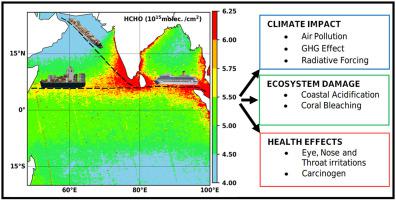当前位置:
X-MOL 学术
›
Atmos. Environ.
›
论文详情
Our official English website, www.x-mol.net, welcomes your
feedback! (Note: you will need to create a separate account there.)
A decade of satellite observations reveal significant increase in atmospheric formaldehyde from shipping in Indian Ocean
Atmospheric Environment ( IF 4.2 ) Pub Date : 2021-02-01 , DOI: 10.1016/j.atmosenv.2020.118095 G.S. Gopikrishnan , Jayanarayanan Kuttippurath
Atmospheric Environment ( IF 4.2 ) Pub Date : 2021-02-01 , DOI: 10.1016/j.atmosenv.2020.118095 G.S. Gopikrishnan , Jayanarayanan Kuttippurath

|
Abstract Atmospheric formaldehyde (HCHO) is a potential pollutant and very harmful to public health at higher doses. There are different sources for HCHO in the atmosphere, in which fuel combustion and biomass burning are predominant. The oxidation of hydroxyl radicals (OH) and methane are the chemical production pathways of HCHO in the troposphere. Here, we show a different source of HCHO emission to the atmosphere; the maritime shipping. The analyses using satellite measurements for the period 2005–2014 reveal large amounts of HCHO release along the ship routes in Indian Ocean, about 7–8 x1015 molec./cm2. This is nearly twice (150–200%) the ambient or background HCHO levels (about 4 × 1015 molec./cm2), when there is no ship emissions in the north Indian Ocean. The trend in HCHO concentrations over the Indian Ocean sea routes is about 0.008 × 1015 molec./cm2/year. The amount and the increasing trends of HCHO over the maritime routes in the north Indian Ocean are also comparable to those of the busiest sea-lanes in the world Oceans, such as the Panama Canal, Mediterranean Sea and Strait of Malacca. Our analyses, henceforth, suggest use of a better fuel for shipping to reduce the maritime pollution, as the polluted air can often be transported to the coastal regions and islands, which is a concern for public health in those regions.
中文翻译:

十年的卫星观测显示,印度洋航运造成的大气甲醛显着增加
摘要 大气甲醛(HCHO)是一种潜在的污染物,在较高剂量下对公众健康非常有害。大气中 HCHO 的来源有多种,其中燃料燃烧和生物质燃烧占主导地位。羟基自由基(OH)和甲烷的氧化是对流层中 HCHO 的化学生成途径。在这里,我们展示了排放到大气中的 HCHO 的不同来源;海运。使用 2005-2014 年期间的卫星测量进行的分析显示,印度洋航线沿线有大量 HCHO 释放,约为 7-8 x1015 摩尔/平方厘米。当北印度洋没有船舶排放时,这几乎是环境或背景 HCHO 水平(约 4 × 1015 摩尔/平方厘米)的两倍 (150–200%)。印度洋海上航线上 HCHO 浓度的趋势约为 0。008 × 1015 molec./cm2/年。北印度洋海上航线上HCHO的数量和增长趋势也可与世界上最繁忙的海洋航道如巴拿马运河、地中海和马六甲海峡相媲美。今后,我们的分析建议使用更好的航运燃料来减少海洋污染,因为被污染的空气通常会被输送到沿海地区和岛屿,这对这些地区的公共卫生来说是一个问题。
更新日期:2021-02-01
中文翻译:

十年的卫星观测显示,印度洋航运造成的大气甲醛显着增加
摘要 大气甲醛(HCHO)是一种潜在的污染物,在较高剂量下对公众健康非常有害。大气中 HCHO 的来源有多种,其中燃料燃烧和生物质燃烧占主导地位。羟基自由基(OH)和甲烷的氧化是对流层中 HCHO 的化学生成途径。在这里,我们展示了排放到大气中的 HCHO 的不同来源;海运。使用 2005-2014 年期间的卫星测量进行的分析显示,印度洋航线沿线有大量 HCHO 释放,约为 7-8 x1015 摩尔/平方厘米。当北印度洋没有船舶排放时,这几乎是环境或背景 HCHO 水平(约 4 × 1015 摩尔/平方厘米)的两倍 (150–200%)。印度洋海上航线上 HCHO 浓度的趋势约为 0。008 × 1015 molec./cm2/年。北印度洋海上航线上HCHO的数量和增长趋势也可与世界上最繁忙的海洋航道如巴拿马运河、地中海和马六甲海峡相媲美。今后,我们的分析建议使用更好的航运燃料来减少海洋污染,因为被污染的空气通常会被输送到沿海地区和岛屿,这对这些地区的公共卫生来说是一个问题。











































 京公网安备 11010802027423号
京公网安备 11010802027423号